Earthballs
There are four types of Earthball in the UK, Common Earthball (Scleroderma citrinum), Leopard Earthball (Scleroderma areolatum), Potato Earthball (Scleroderma bovista) and Scaly Earthball (Scleroderma verrucosum), all are similar but the Scaly Earthball is darker in colour, Potato Earthball is often paler. They are a very common group of fungi, especially the Common Earthball which appears to be responsible for the second most mushroom poisonings each year in the UK. This is possibly due to confusion with Common Puffball (Lycoperdon perlatum) or even Truffles (Tuber spp.).
| Mushroom Type | |
| Common Names | Common Earthball (EN), Poison Pigskin Puffball (US), Coden Euraid (CY), Tęgoskór Cytrynowy (PL), Rőt Áltrifla (HU), Leopard Earthball (EN), Coden Smotiog (CY), Tęgoskór Lamparci (PL), Leopárd-Áltrifla (HU), Potato Earthball (EN), Coden Glorog (CY), Tęgoskór Kurzawkowy (PL), Fakó Áltrifla (HU), Scaly Earthball (EN), Coden Ddafadennog (CY), Tęgoskór Brodawkowany (PL), Nyeles Áltrifla (HU) |
| Scientific Name | Scleroderma spp. |
| Season Start | Jul |
| Season End | Nov |
| Average Mushroom height (CM) | 8 |
| Average Cap width (CM) | 12 |
Fruiting Body
Generally spherical, irregular or potato shaped. Ranging from white to tan to brown with a darker wart like covering and a thick leathery skin.
Flesh
Inside the mushroom has a purple/brown to black interior with small white ‘veins’ running through. When very young the interior of the mushroom can appear whitish or slightly pink/purple but is never pure white like a Puffball. When mature the interior becomes powdery and the outer skin will develop pores or splits through which the spores can be distributed when the mushroom is disturbed or rained on.
Spore Print
Brown. Globose with a net like covering.
Taste / Smell
A bit like rubber.

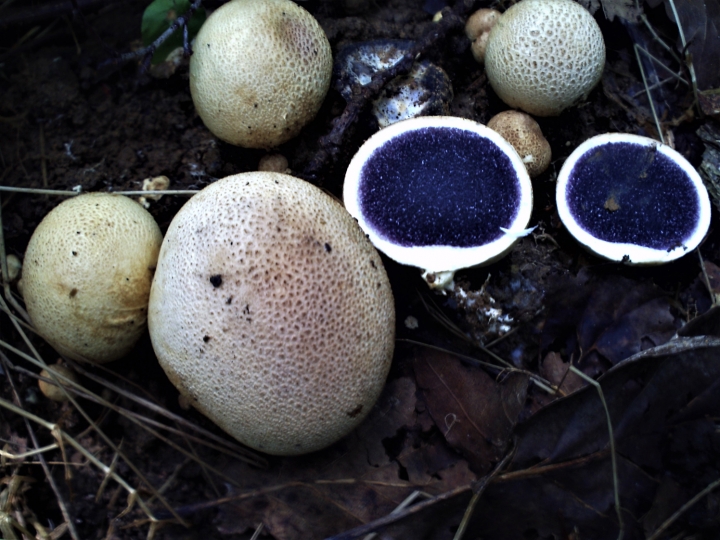
















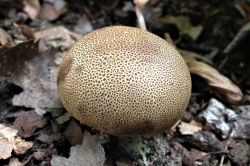
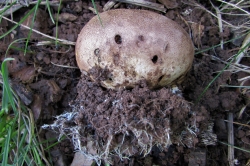
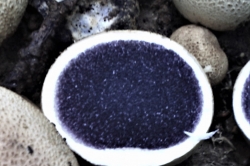
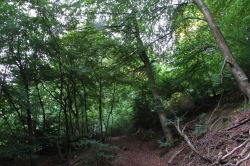





15 comments for Earthballs
If I send a photo of a mushroom thing I found in the garden would you be able to identify it
Possibly, we would need clear photos of the caps, gills and stem to have a chance, send them to [email protected] and I’ll see what I can do.
Thankyou for your clear identification. I have lots of these growing on my veg patch. Will they do any harm? Should I get rid of them, if so, how?
They shouldn’t do any harm, they might even be doing good.
We have found a fungi in an elongated ball shape with a bright orange spongey interior at the end of our garden on the edge of a forest under an old oak tree, growing on woody matter, bark clippings etc I can’t identify it. Do you have any idea what it might be please?
If you can send in clear photos of the mushroom from above and below and the interior to [email protected], I’ll try to ID it for you.
What happeneds if you inhale the powder
As the mushroom is poisonous, it could cause serious illness. People who have consumed them thinking they were edible puffballs usually end up in hospital.
Hi, I stupidly cut open an earth ball in my house – to see if it looked like an earth ball inside or a puffball. It smelt very strongly and now my utility stinks. Could I get ill from smelling after cutting?
Unless you directly inhaled the spores, as in snorting them, you should be fine.
My dog loves to dig up and eat something like these. She sniffs them out, digs them up and devours them with relish. Why do you think she loves them so much?
Loila my dog does the same thing. Any reply to your post about dogs eating them?
Your dog is possibly finding ground truffles which are delicious & if your dog is not sick or dead I would save one or some before she eats them and have them properly identified as you could have a gold mine with your dog as being a natural truffle hunter. Which usually takes dedicated training
I found what looks like a truffle and has the aroma of hazelnut but looks grayish on the inside. It looks like it’s not ripe. I only found this spot bc I love to woods and lives and animals of all kinds has the ground all rooted. How can I find out for sure?
We would need to see photos of the possible truffle to be able to confirm an ID. Please send them to [email protected]